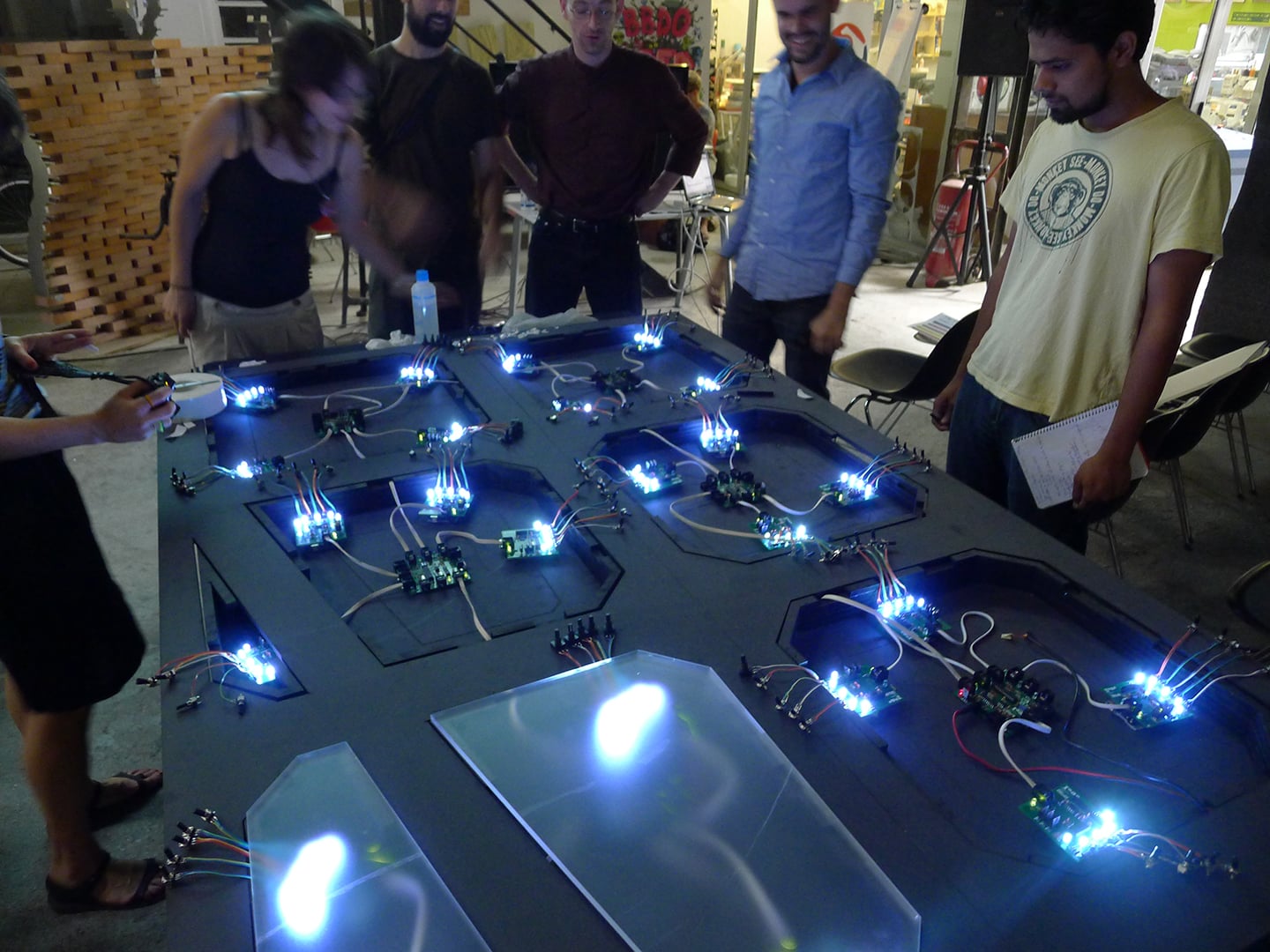NetworkedCITY is a project that combines physical computing, data visualisation and real-time computation by the use of interoperable devices, applications and models. The project is based on a physical simulation model of a continuously transformed city and a real-time data visualisation which allows understanding the interconnection between the environment that surrounds us, the energy we consume and produce, the water we consume and the geographical data of our habitat.
NetworkedCITY:
The aim of the NetworkedCITY project is to create an urban tool for planners and city managers as well as to stimulate processes of citizen’s awareness, promoting and testing to ensure everything is interconnected and that the networks of people, technology, information and city infrastructure are affecting the way that we interact, produce and behave.
The NetworkedCITY project debates how we can think about the cities of the future, not in terms of new construction, but on how we can optimise the constructed environment, how we can take advantage of that invisible layer of information, and how we generate a platform to understand the relations of energy, environment, production, economy and resources into the city.

NetworkedCITY consists of two different electronic DIY (Do It Yourself) boards that are able to capture real-time data and interchange information among them. The HUB (master) is located in the centre of each urban block and the BUILDING (slave) board is located in each building of the urban block.
The HUB is able to receive real-time data from the BUILDING board that captures information about the building and send it to the HUB.
Information captured and interchanged is based on sensors measuring energy consumption and generation, water consumption, levels of CO2 emissions, amount of light, temperature and sound. Hubs of each urban block of the city are interconnected using a communication protocol that enables them to interchange information and real-time data converting the city into a networked informational system.
NetworkedCITY uses CAN communication protocol so that the boards that are implemented in buildings and centre of urban blocks could exchange and manage information. An algorithmic mathematical formula is translating the values of the data collected to five colours according to levels of efficiency (the greenest represents the most optimum areas and the reddish the less optimum ones).
The project functions as a physical simulator where proposed strategies of intervention can be tested to reveal the influence on the levels of efficiency in each building, in the network of buildings (block) and in the network of blocks (neighbourhood). Through proposed strategies, one building unit with low efficiency can contribute to the network in order to achieve the most optimised balance of existing resources according to different timing during the day, week, season. A sports stadium, for example, consumes a lot of energy but only the timings of events, therefore, the system can manage a more intelligent distribution of energy resources towards the stadium when it functions and from the stadium towards surrounding buildings when it is not.
Barcelona Interactive Model is a solution based on the multiscalarity of the used technology. The solution is applied to a model in scale 1:500 and the exact same technology can be applied in the city in scale 1:1.
Barcelona NetworkedCITY is an urban tool to test how can information affect the construction of the physical world.
A Detailed Description of Electronic Components:
There are two kinds of boards:
- The master
- The slave
The Master is a fully integrated board, equipped with an Atmega168 microcontroller+ CAN bus RJ11 connection to be linked with other boards on the model. The master works as a block hub, receiving the information from the slaves and other masters. The master board will manage the information within the block and will be able to exchange the data with the other blocks on the superblock.
The slave board has the architecture of an Arduino shield, which can be attached to standard Arduino’s. The slave is a representation of the scale of the building and is able to handle the information of five inputs (database, pachube feeds or sensors) and five outputs, represented with RGB LED’s displaying the behaviour of the network. The LED’s transitions are used for RGB multiplexing. The slave interface is an RJ11 connector powering “HUB” board and CAN communication.
NetworkedCITY system is a project of IAAC, Institute for Advanced Architecture of Catalonia in collaboration with Hangar, developed in the Global Summer School programme in 2011 by:
Faculty:
- Areti Markopoulou
- Tomas Diez
Guest faculty:
- Vicente Guallart
- Willy Muller
- Marta Malé-Alemany
- Antoni Brei
- Enric Ruiz-Geli
- Massimo Banzi
Assistants :
- Chrisa Karakana
- Mani Khosrovani
- Anastasia Pistofidou
- Jordi Portel y Torres
- Tomas Vivanco Larrain
Students:
- Diana Villareal Ramirez
- Cristina Hidalgo Leon
- Daniela Eugenia Melo Gonzalez
- Maricarmen Conaway Mediavilla
- Hoki Au
- Ecem Ezmeci
- Mariano Moya Alfaro
- Inaki Hernandez Amelibia
- Hassan Ragab
- Gina Paola Gaudiano Vaccaro
- Ruben Taboada, Agim Kercuku
- Quirino Spinelli
- Jennifer Robin Caras
- Ilias Antoniou, Pietro Leoni
- Yana Petrova
- Nicolas Papas
- Olivia Kotsifa
- Joshua Parker
- O Conail Oisin
- Meng Sun
